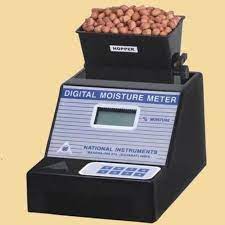No products in the cart.
Return To Shop
0
₦0.00
0
Shopping cart (0)
Subtotal: ₦0.00
Spend ₦500.00 to get free shipping Congratulations! You've got free shipping.
Log in / Sign up
Login Register
Standardized Weights (For Bala...
₦29,950.00


1000kg Digital Floor Weighing ...
₦354,362.50
Moisture Meter for Grain
₦360,000.00
A moisture meter for grain is a handheld device that measures the moisture content of grains, such as corn, wheat, rice, and soybeans. It is an essential tool for farmers, grain traders, and food processors to ensure the quality and safety of their grain.
benefits of using a moisture meter for grain include:
- Improved quality control: The moisture meter can help to ensure that the grain is of the desired moisture content, which is important for quality and safety.
- Increased efficiency: The moisture meter can help to save time and money by eliminating the need to send grain samples to a laboratory for testing.
- Improved decision-making: The moisture meter can help farmers, grain traders, and food processors to make better decisions about the storage, handling, and processing of grain.
If you are looking for a reliable and accurate way to measure the moisture content of grain, then a moisture meter is the perfect tool for you.
16 people are viewing this product right now
Please, activate Compare option to use this widget.
SKU: moisture-meter-for-grain-digital-table-top-probe-models Categories: Farm Input Categorized, Agricultural Equipment Tags: Digital, grain, Meter, Moisture, Probe Models, Table Top
Estimated delivery:4 days
Share:
Moisture Meter for Grain
A moisture meter for grain is a handheld device that uses a probe to measure the electrical conductivity of the grain. The higher the moisture content, the more conductive the grain will be. The moisture meter then converts this conductivity reading into a percentage of moisture content.
Moisture meters for grain are available in a variety of models, with different features and price points. Some of the key features to consider include:
- Accuracy: The moisture meter should be accurate to within +/- 0.5% moisture content.
- Speed: The moisture meter should be able to provide a reading quickly, typically within a few seconds.
- Durability: The moisture meter should be durable enough to withstand the rigors of everyday use.
- Ease of use: The moisture meter should be easy to use, even for users with no prior experience.
- Functions: In addition to measuring moisture content, some moisture meters can also measure temperature, density, and other properties of grain.
- Benefits: Moisture meters can help to improve the quality, safety, and efficiency of grain handling and processing. They can also help to prevent spoilage and loss.
- Tips: When using a moisture meter, it is important to follow the manufacturer’s instructions carefully. It is also important to calibrate the moisture meter regularly to ensure accurate readings.
Frequently Asked Questions (FAQs) about Grain Moisture Meters
What is a grain moisture meter and how does it work?
A grain moisture meter is a portable device that measures the water content of grain kernels. It uses a probe to conduct electricity through the grain. Since wetter grain conducts electricity more easily, the meter can measure the electrical conductivity and convert it into a moisture content percentage.
What are the benefits of using a grain moisture meter?
There are several benefits to using a grain moisture meter, including:
- Improved grain quality: Knowing the moisture content allows you to store and process your grain at optimal conditions, preventing spoilage and maintaining its quality.
- Safety: Grains with excessive moisture can develop mold and become unsafe for consumption. Moisture meters help ensure your grain stays within safe moisture levels.
- Efficiency: Properly dried grain is easier and less expensive to store and transport.
- Reduced losses: By preventing spoilage and ensuring proper drying, you minimize grain loss.
What are some key features to consider when choosing a grain moisture meter?
- Accuracy: Look for a meter with an accuracy of +/- 0.5% moisture content.
- Speed: A fast reading time (usually within seconds) is ideal for efficient use.
- Durability: Choose a meter built to withstand regular use in potentially harsh environments.
- Ease of use: A user-friendly interface is important, especially for those without prior experience.
- Additional Functions: Some meters offer features like measuring temperature, density, or other grain properties.
What are some tips for using a grain moisture meter?
- Follow the manufacturer’s instructions: Each meter might have slight variations in operation.
- Calibrate regularly: Consistent calibration ensures accurate readings.
- Take multiple readings: Get a representative sample by testing from various locations within the grain bin or pile.
- Consider grain temperature: Some meters require temperature adjustment for accurate results.
Only logged in customers who have purchased this product may leave a review.
Related products
Sale 7%
Horivacao Cocon...
🔥 8 items sold in last 3 hours
Rated 3.75 out of 5


4.33
9 reviews for Moisture Meter for Grain
There are no reviews yet.